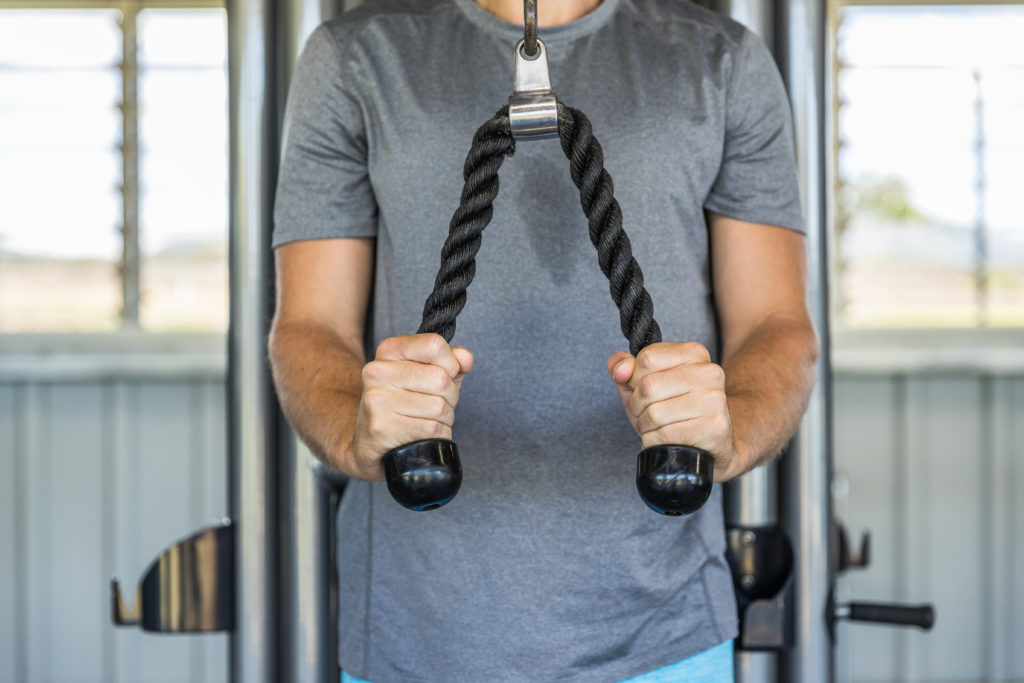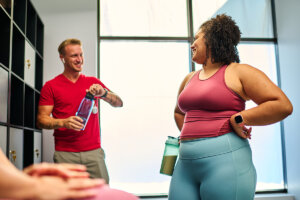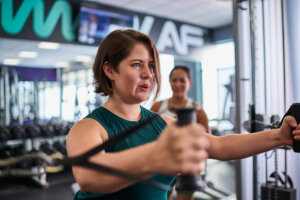The cable rope attachment is extremely versatile, and great for adding resistance to strengthen your arms. So much so, dedicated cable rope users will sometimes carry one in their gym bag, just in case! Cable exercises can make for a really effective arm workout, and a cable rope handle attachment in particular allows you to perform arm exercises like cable face pulls or triceps pushdowns. As long as the machine has weight stacks and a cable pulley (as the best cable machines do), you can attach your cable rope! Cable rope face pulls are probably the best-known cable rope exercise, but there are plenty of ways to utilize the cable rope besides face pulls. Beyond the pushdown, curl, and pull, it’s the perfect choice for variations in leg exercises, core movements, and upper body training for great full-body workouts!
Now that you know what a great product the cable rope is, you probably want to dive in and learn how to use it, right? We get it, but first, let’s talk about what makes up the best cable machine, and why it’s a great choice for any and all gym work.
The Cable Machine
Walk into any fitness club (or even a home gym), and chances are you’ll see a cable machine among the different weight machines like the Smith machine and the power rack. The cable machine’s design is made up of a steel frame, similar to the Smith machine, with either one or dual weight stacks of plates and a pulley system. Depending on the brand, each product might look a bit different, but they all serve the same purpose!
Here’s a few reasons why the cable machine is the perfect choice for your next workout:
They’re adaptable. One of the best things about the cable machine’s design is that it allows for adjustment. This is a good thing! Because the machine allows you to move the anchor point, you can work from different angles and train multiple areas of your body. Aside from that, you can also change out the cable attachments, which allows you to perform a variety of exercises without ever leaving the machine (talk about a smart design!). Any exercise you can do with free weights or a pair of dumbbells can be replicated on the cable machine. Need a good shoulder workout? Or back workout? How about an entire body workout? The cable machine has you covered!
They reduce the chance of injury. No matter your fitness level, cable machines are a great way to make gains in your journey. If you’re just starting out, they can help you practice good form and develop a strong foundation—just remember to use light weights in the beginning and consult with a personal trainer or coach if you have questions. As you progress, the cable machine can be a great way to challenge yourself and build towards more difficult moves, like doing grip lat pulldowns to get better at pull-ups. Plus, if you’re working towards building muscle mass and finding your maximum weight on a lift and have too much weight selected, you can safely let go thanks to the pulley’s design. Just beware, the weight stacks will slam, and they aren’t quiet!
They work your core. Depending on the exercise and cable attachment, you’ll likely find yourself using core strength to keep yourself balanced and stable, no matter which target muscles you’re aiming to work. Take the seated cable row for example; not only are you using the target muscles of your latissimus dorsi and other back muscles, but you’re also engaging your core muscles, too! And who doesn’t love a 2-for-1 workout? We know we do.
Now, let’s focus on one of our favorite attachments: the cable rope.
Cable Rope 101
The cable rope, also known as the tricep rope, is a cable pulley attachment made from a piece of thick rope with dual handles. This cable handle’s design looks like large knobs, but you can also find cable or tricep ropes with stirrup handles—it just depends on the brand. Made from rope rather than a metal bar, the cable or tricep rope’s flexibility is what makes it so effective for your arms, particularly for face pull exercises.
Cable ropes are sometimes confused for battle ropes, however, each product is used very differently. Battle ropes are low to the ground, attached to a wall, and much longer than a cable rope! While both battle ropes and cable ropes strengthen your arms, they’re very different, and you’ll know which one you’re supposed to be using for your arm workout right when you see them! The cable rope is also different from a rope trainer, which is a machine to help strengthen your rope climbing ability. The cable rope is an attachment for a cable pulley machine, while the rope trainer is its own separate machine. While rope trainers are for improving your climbing skills, cable ropes are better for amping up your overall upper body strength.
We also think it’s worth noting that this cable rope is far different from what you’ll see in rock climbing. However, cable rope exercises can definitely improve your rock-climbing ability if you’re a regular climber! Rock climbing requires a lot of arm and core strength, and as you’ll read below, cable rope exercises are a great way for building just that.
Cable rope exercises offer lots of benefits and are great for building muscle in your rear deltoids (and side delts), shoulders, upper arms and forearms. Plus, cable ropes can give your shoulder muscles and joints a must-needed break from free weights. The best shoulder exercises with a cable machine will strengthen your external shoulder rotators, which is important if you’ve experienced shoulder injuries. There are a few pieces of key information to remember before you get started with cable rope exercises, to get the most effective workout with the best form, whether its arm or leg day.
- Make sure you have a firm, even grip with both hands.
- Keep the left and right hand in the same spot on the cable rope.
- Plant your feet firmly on the floor, about shoulder width or hip width apart.
- Your knees should be slightly bent – locked knees are never a good idea – and your hips can be neutral.
- If you’re new to the cable machine, start with light weight until you feel comfortable. Don’t forget to ask a coach or watch a video if you have questions on a specific move. (Tip: be sure to watch a video from a reputable source because there are a lot of incorrect videos out there!)
Note that while some cable rope exercises can be done in a seated position (like the lat pulldown), it’s best to do the three exercises below while standing, rather than in a seat.
If you’re at the gym (or in your home gym) without a cable rope, you can substitute a resistance band or light dumbbells for some of the exercises below! Pick the resistance band that’s best for your strength and body weight, and tie it to something sturdy, like the top of a squat rack or Smith machine. Then perform the moves below as best you can with the added resistance. Now, let’s get to all the information on these great moves!
Once you master these three basic arm moves, and you’ll be a cable rope pro in no time!
3 Great Beginner Cable Rope Exercises
Triceps Pushdown
Here’s some helpful information on triceps: Our triceps muscles consist of three heads, or points of origin: the medial, lateral, and long head. The most efficient way to train all three is using a full range of motion—just as you would with any other muscle group. And the trick to getting all three heads involved in the Triceps Pushdown is for the user to tilt your torso forward at a 30- to 40-degree angle, instead of standing straight up.
- Start off standing in front of a cable machine with your feet hip-width apart (or shoulder width) and a slight bend in your knees. Attach a rope to the high pulley and grab the attachment with an overhand grip. Make sure your right and left hand are in-line with each other.
- Keeping your abs drawn in, back straight, and elbows in at your sides, push the rope down toward your thighs.
- As you push down, split the rope apart at the bottom and isolate the tricep muscle.
- Hold this position for a count and return back up to the starting position. Repeat for as many reps as necessary.
Hammer Curl
Similar to the info we shared about triceps, our biceps consist of two heads, and hammer curls help build both the brachialis and brachioradialis in a way other curl variations simply do not.
- Attach the rope toward the bottom of the cable machine so it gives you room to move but assists your controlled motion.
- Place your feet hip-width apart; each knee should have a slight bend. Next, hold the cable rope with both hands at the height of your hips.
- Curl the rope up so that your hands are at shoulder height.
- Uncurl and return the rope to the height of your hips.
- Curl up again from your hips and repeat for as many reps as necessary.
Working the brachialis is particularly important if you’re looking to beef up your guns. This exercise is great for your forearms, too, and will also build upper body and core strength for doing daily activities like picking up children, doing household chores, and lifting grocery bags!
Face Pull
Cable rope face pulls might be the most underutilized exercise out there. This face pull exercise serves as both an awesome muscle-building exercise and a highly effective movement for improving shoulder health and posture. Cable face pulls are great for building rear deltoids, traps, rhomboids, and rotator cuff muscles. The deltoid muscles are made up of three separate parts: the anterior (front delts), lateral (side delts), and posterior (rear delts). Rear deltoids can be a tricky muscle to strengthen (unless you’re doing those rear delt flies!), so we love how the cable rope works our rear deltoids. And! They are one of the very best exercises for treating and preventing internal rotation of the shoulder joint—a.k.a. rounded shoulders. Cable rope face pulls will help to rotate your shoulders back into the proper position for better posture and decreased injury risk—something free weights or a pair of dumbbells can’t do!
One quick note: while the cable rope attachment is perfect for cable face pulls, you don’t want to use it for a lat pull. You’ll want to perform lat pulls with a lat bar, of course, so you can maintain proper form!
To perform cable rope face pulls properly:
- Grab the rope attachment and set it at the height of your upper chest.
- Rather than gripping the rope from the top with your palms facing down like most people do, instead, grip it from underneath with a neutral hammer-style grip.
- With your feet hip-width apart and a slight bend in your knees, keep your chest up, shoulders back and retract your shoulder blades.
- Pull the rope back towards your face while at the same time imagining that you’re trying to pull the rope apart. Make sure you aren’t crunching your neck in!
- Pause in the fully contracted position and focus on squeezing your rear delts and upper back before returning to the starting position. Repeat cable face pulls, following the same steps, for as many reps as necessary.
Ready? Get out there and give the cable rope a try. Your muscles won’t be disappointed! And remember: Just about any exercise you can do with a dumbbell or barbell can be replicated with the cable machine. Here’s a few examples to get you started.
Shoulder Exercises
Overhead Press or Shoulder Presses
When it comes to shoulder training, the overhead press is one of the best shoulder exercises out there. While there are many different variations, like the seated dumbbell shoulder press or overhead barbell presses, they all work the same muscles. To do this movement with the cable machine, you’ll want to find a machine with a double pulley design, or a cable crossover machine.
Lateral Raise or Front Raise
The dumbbell lateral raise is another staple you’ll find in the best shoulder workouts. To do a lateral raise with the cable machine, just be sure to set the anchor point so that you’re pulling the handle from a low cable position. Then, stand with your feet hip-width apart either next to, or in front of, the machine and go for it!
Back Exercises
Rear Delt Fly
If you’re looking for a great way to strengthen your back muscles, front, back, and side delts, the rear delt fly is it! One of the best ways to perform this movement is with a cable crossover machine. Stand with your feet shoulder-width apart and grab the left handle with your right hand and vice-versa. Fly each arm out to the side as you would with dumbbells!
Push Press
The most common variation of this move is the dumbbell push press, but you can also do a push press with a barbell, too. If you’d like to try this movement with cables, the crossover cable machine would be a great way to get started, otherwise you can do this with a single cable system. Hold one handle in each hand as you would if you were doing the dumbbell push press, with your feet shoulder-width apart. Similar to the dumbbell push press, squat down and press each handle overhead as you stand up. When done correctly, this can work your upper back muscles, shoulders, arms, and even lower body!
For a challenge, try stepping your right foot out in front of you. Push one arm out, as you pull the other arm in—sort of like a chest press. Don’t forget to switch legs!
Row
The row is another common exercise that targets the upper and lower back, front and side delts, and even the arms. The dumbbell row can be easily transformed into a cable row, with the option to use a V-bar attachment for a narrow grip or a straight bar for a wide grip (similar to one you’d use for the lat pulldown). If you don’t have either of these attachments, you may use a basic handle and complete a single-arm cable row instead. One of the most important things for this exercise is that you’re seated or kneeling—either on a bench or the floor.
Leg Exercises
If your cable machine at the gym (or your home gym) has ankle straps, get ready for an incredible lower body workout! Once you hook on the ankle straps, you can do lunges, squats, kick-backs, and so much more.
Need more ideas? Download the Anytime Fitness app for videos and content on workouts, weight loss, and nutrition to get started. You’ll find a video illustration for each exercise that you can do in the club or at your home gym. Otherwise, if videos don’t cut it, you can always ask a coach!



